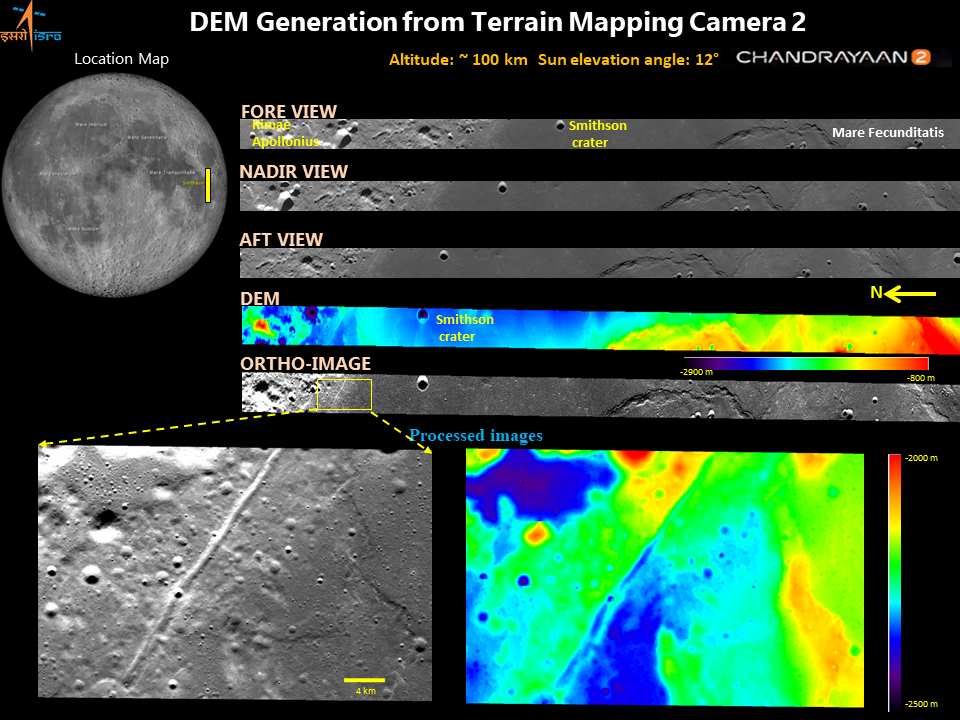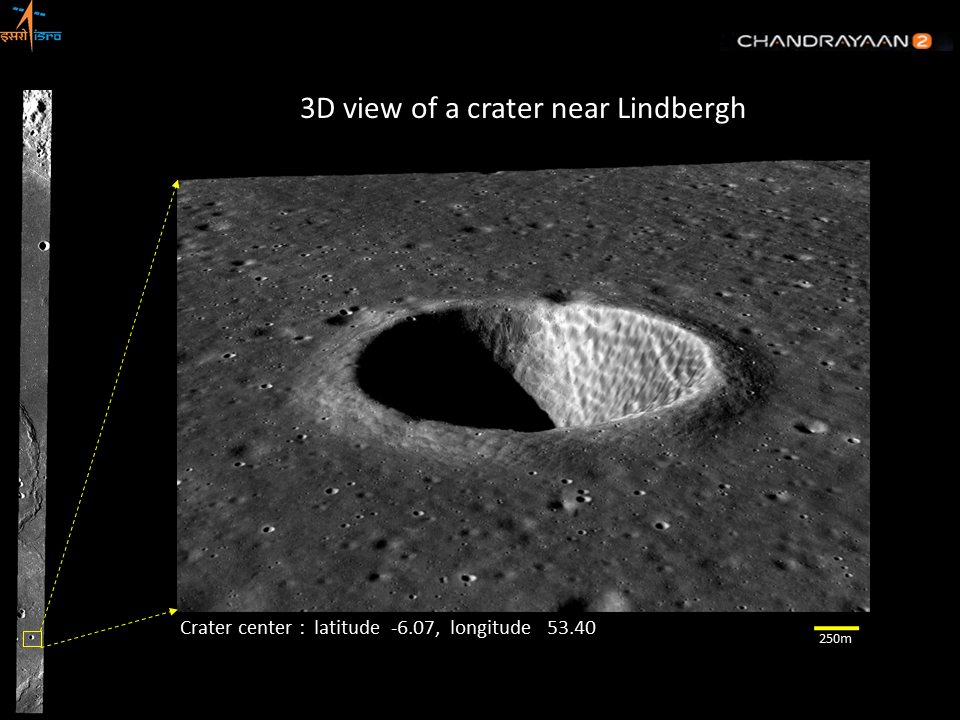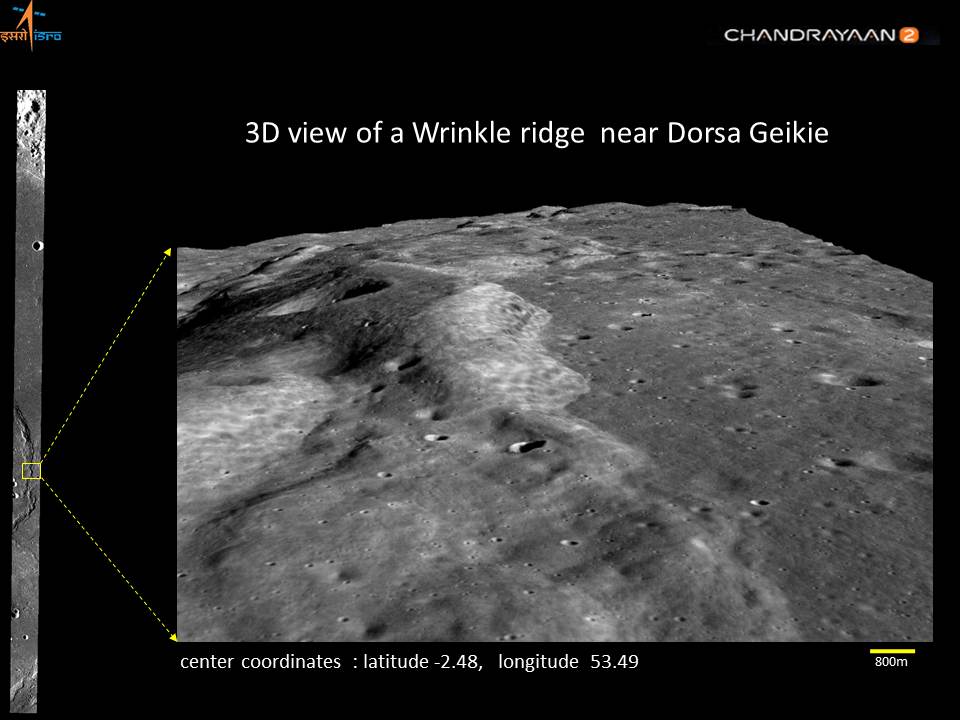The Indian Space Research Organisation (ISRO) has released new images showing the different terrains on the lunar surface. The orbiter, which has several scientific, imaging and mapping instruments onboard, has captured its first three-dimensional map of a structure on the moon — an impact crater. The map is the first comprehensive three-dimensional (3D) map of a lunar crater and was captured by the orbiter’s Terrain Mapping Camera-2 (TMC-2), an upgraded version of the TMC that accompanied the Chandrayaan 1 mission over a decade ago. The TMC-2 instrument can provide images at 5m-spatial resolution from an altitude of 100 km to create a “Digital Elevation Model” or DEM of the entire lunar surface. [caption id=“attachment_7649031” align=“alignnone” width=“960”] A multi-factoral map of a patch of lunar surface as seen by the Chandrayaan 2’s TMC-2 camera. Image: ISRO[/caption] The TMC-2 is the successor of the TMC that was present on the Chandrayaan-1 mission. It’s capable of taking images from a distance of 100 km while orbiting. Images are captured by a stereo triplet system where different images are captured in three separate views including ‘fore’, ‘nadir’, and ‘aft’. These images are combined to generate a Digital Elevation Model or DEM of the entire lunar surface.
A multi-factoral map of a patch of lunar surface as seen by the Chandrayaan 2’s TMC-2 camera. Image: ISRO[/caption] The TMC-2 is the successor of the TMC that was present on the Chandrayaan-1 mission. It’s capable of taking images from a distance of 100 km while orbiting. Images are captured by a stereo triplet system where different images are captured in three separate views including ‘fore’, ‘nadir’, and ‘aft’. These images are combined to generate a Digital Elevation Model or DEM of the entire lunar surface.
[caption id=“attachment_7647151” align=“alignnone” width=“960”]
 3D images of a crater created by the Terrain Mapping Camera-2 on the Chandrayaan 2 Orbiter. Image: ISRO[/caption] The DEMs are capable of mapping various types of surface morphologies including craters, lava tubes, rilles (furrows formed by lava channels or collapsed lava tubes), Dorsa or Wrinkle ridges (formed mostly in Mare regions depicting cooling and contraction of basaltic lava), Graben structures (depicts the structural dislocations on the lunar surface) and lunar domes. By enabling the capture of this data, ISRO can potentially reconstruct the morpho-structural framework by estimating the dimensions of the above landforms. Impact geometries can be derived from characterising craters and Crater Size-Frequency Distribution (CSFD) methods can be applied to determine surface age. Rheological analysis can be carried out as well based on the derived morphometric parameters and the lunar reflectance can be estimated among other things. [caption id=“attachment_7649101” align=“alignnone” width=“960”]
3D images of a crater created by the Terrain Mapping Camera-2 on the Chandrayaan 2 Orbiter. Image: ISRO[/caption] The DEMs are capable of mapping various types of surface morphologies including craters, lava tubes, rilles (furrows formed by lava channels or collapsed lava tubes), Dorsa or Wrinkle ridges (formed mostly in Mare regions depicting cooling and contraction of basaltic lava), Graben structures (depicts the structural dislocations on the lunar surface) and lunar domes. By enabling the capture of this data, ISRO can potentially reconstruct the morpho-structural framework by estimating the dimensions of the above landforms. Impact geometries can be derived from characterising craters and Crater Size-Frequency Distribution (CSFD) methods can be applied to determine surface age. Rheological analysis can be carried out as well based on the derived morphometric parameters and the lunar reflectance can be estimated among other things. [caption id=“attachment_7649101” align=“alignnone” width=“960”] A high-resolution image of a patch of lunar surface as seen by the Chandrayaan 2’s TMC-2 camera. Image: ISRO[/caption] Previously, ISRO had announced the
detection of Argon-40
in the lunar exosphere. Before that, it had released images of
illuminated images and data
from the Orbiter’s infrared instruments. After an uncomfortably long silence, the Indian Space Research Organisation (ISRO) had
released images and the first scientific data
from the Chandrayaan 2 mission, which is survived by the Orbiter. Captured by the Orbiter’s High-Resolution Camera (OHRC) from an altitude of ~100 km, ISRO shared that the images are the highest resolution visuals ever taken of the Moon. The mission’s lander Vikram and rover Pragyan, which
crash-landed on the Moon
during a soft-landing attempt on 7 September, continue to be incommunicado with ISRO.
A high-resolution image of a patch of lunar surface as seen by the Chandrayaan 2’s TMC-2 camera. Image: ISRO[/caption] Previously, ISRO had announced the
detection of Argon-40
in the lunar exosphere. Before that, it had released images of
illuminated images and data
from the Orbiter’s infrared instruments. After an uncomfortably long silence, the Indian Space Research Organisation (ISRO) had
released images and the first scientific data
from the Chandrayaan 2 mission, which is survived by the Orbiter. Captured by the Orbiter’s High-Resolution Camera (OHRC) from an altitude of ~100 km, ISRO shared that the images are the highest resolution visuals ever taken of the Moon. The mission’s lander Vikram and rover Pragyan, which
crash-landed on the Moon
during a soft-landing attempt on 7 September, continue to be incommunicado with ISRO.
)